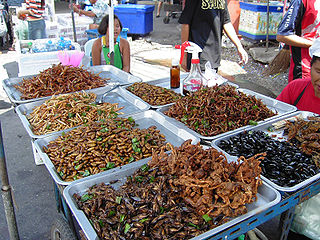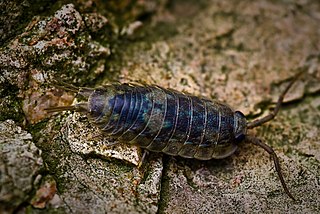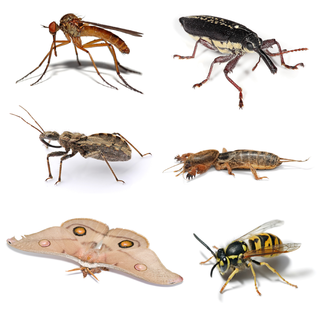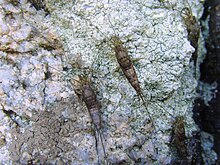
Metamorphosis is a biological process by which an animal physically develops after birth or hatching, involving a conspicuous and relatively abrupt change in the animal's body structure through cell growth and differentiation. Some insects, fishes, amphibians, mollusks, crustaceans, cnidarians, echinoderms, and tunicates undergo metamorphosis, which is often accompanied by a change of nutrition source or behavior. Animals can be divided into species that undergo complete metamorphosis ("holometaboly"), incomplete metamorphosis ("hemimetaboly"), or no metamorphosis ("ametaboly").

Entomology is the scientific study of insects, a branch of zoology. In the past the term "insect" was vaguer, and historically the definition of entomology included the study of terrestrial animals in other arthropod groups or other phyla, such as arachnids, myriapods, earthworms, land snails, and slugs. This wider meaning may still be encountered in informal use.

True flies are insects of the order Diptera, the name being derived from the Greek δι- di- "two", and πτερόν pteron "wings". Insects of this order use only a single pair of wings to fly, the hindwings having evolved into advanced mechanosensory organs known as halteres, which act as high-speed sensors of rotational movement and allow dipterans to perform advanced aerobatics. Diptera is a large order containing an estimated 1,000,000 species including horse-flies, crane flies, hoverflies and others, although only about 125,000 species have been described.

The Hemiptera or true bugs are an order of insects comprising some 50,000 to 80,000 species of groups such as the cicadas, aphids, planthoppers, leafhoppers, and shield bugs. They range in size from 1 mm (0.04 in) to around 15 cm (6 in), and share a common arrangement of sucking mouthparts. The name "true bugs" is sometimes limited to the suborder Heteroptera. Many insects commonly known as "bugs" belong to other orders; for example, the lovebug is a fly and the May bug and ladybug are beetles.

A pupa is the life stage of some insects undergoing transformation between immature and mature stages. The pupal stage is found only in holometabolous insects, those that undergo a complete metamorphosis, with four life stages: egg, larva, pupa, and imago. The processes of entering and completing the pupal stage are controlled by the insect's hormones, especially juvenile hormone, prothoracicotropic hormone, and ecdysone.

The Phasmatodea are an order of insects whose members are variously known as stick insects, stick-bugs, walking sticks or bug sticks. They are generally referred to as phasmatodeans, phasmids, or ghost insects. Phasmids in the family Phylliidae are called leaf insects, leaf-bugs, walking leaves, or bug leaves. The group's name is derived from the Ancient Greek φάσμα phasma, meaning an apparition or phantom, referring to their resemblance to vegetation while in fact being animals. Their natural camouflage makes them difficult for predators to detect; still, many species have one of several secondary lines of defence in the form of startle displays, spines or toxic secretions. The genus Phobaeticus includes the world's longest insects.

The Pterygota are a subclass of insects that includes the winged insects. It also includes insect orders that are secondarily wingless.

Endopterygota, also known as Holometabola, is a superorder of insects within the infraclass Neoptera that go through distinctive larval, pupal, and adult stages. They undergo a radical metamorphosis, with the larval and adult stages differing considerably in their structure and behaviour. This is called holometabolism, or complete metamorphism.

Entomophagy describes the practice of eating insects by humans.

Francis Walker was an English entomologist. He was one of the most prolific authors in entomology, and stirred controversy during his later life as his publications resulted in a huge number of junior synonyms.

The Machilidae are a family of insects belonging to the order Archaeognatha. There are around 250 described species worldwide. These insects are wingless, elongated and more or less cylindrical with a distinctive humped thorax and covered with tiny, close-fitting scales. The colour is usually grey or brown, sometimes intricately patterned. There are three "tails" at the rear of the abdomen: two cerci and a long central epiproct. They have large compound eyes, often meeting at a central point. They resemble the silverfish and the firebrat, which are from a different order, Zygentoma.

Ligiidae is a family of woodlice, the only family in the infraorder Diplocheta. Its members are common on rocky shores, in similar habitats to those inhabited by species of the bristletail Petrobius and the crab Cyclograpsus. The family contains the following genera:

Insects or Insecta are hexapod invertebrates and the largest group within the arthropod phylum. Definitions and circumscriptions vary; usually, insects comprise a class within the Arthropoda. As used here, the term Insecta is synonymous with Ectognatha. Insects have a chitinous exoskeleton, a three-part body, three pairs of jointed legs, compound eyes and one pair of antennae. Insects are the most diverse group of animals; they include more than a million described species and represent more than half of all known living organisms. The total number of extant species is estimated at between six and ten million; potentially over 90% of the animal life forms on Earth are insects. Insects may be found in nearly all environments, although only a small number of species reside in the oceans, which are dominated by another arthropod group, crustaceans.

The Dicondylia are a taxonomic group (taxon) that includes all insects except the jumping bristletails (Archaeognatha). Dicondylia have a mandible attached with two hinges to the head capsule (dicondyl), in contrast to the original mandible with a single ball joint (monocondyl).

The subphylum Hexapoda constitutes the largest number of species of arthropods and includes the insects as well as three much smaller groups of wingless arthropods: Collembola, Protura, and Diplura. The Collembola are very abundant in terrestrial environments. Hexapods are named for their most distinctive feature: a consolidated thorax with three pairs of legs. Most other arthropods have more than three pairs of legs.
Rhysodromus is a genus of spiders in the Philodromidae family. It was first described in 1965 by Schick. As of 2017, it contains 26 species.
Petrobius adriaticus is a species of jumping bristletail in the family Machilidae.
Petrobius artemisiae is a species of jumping bristletail in the family Machilidae.

Petrobius brevistylis is a species of jumping bristletail in the family Machilidae. It is found in Europe & Northern Asia and North America.
Petrobius crimeus is a species of jumping bristletail in the family Machilidae.















